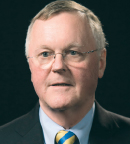
Mastery learning provides excellent training for medical students to ensure that they become as highly skilled as possible, whereas the traditional way of educating medical students by watching senior physicians practice on real patients just doesn’t work very well.— William C. McGaghie, PhD
Tweet this quote
According to William C. McGaghie, PhD, Professor of Medical Education and Professor of Preventive Medicine at Northwestern University Feinberg School of Medicine in Chicago, the principles of today’s clinical medical education are rooted in a 19th century model that is no longer useful in a high-tech 21st century world and needs to be reformed. Dr. McGaghie’s proposed replacement for the old medical education model is a new paradigm called “mastery learning,” a hybrid approach to competency-based education, which has as its central tenets that educational excellence is expected and can be achieved by all learners, and that little or no variation in measured outcomes will be seen among learners in a mastery environment.
The ASCO Post talked with Dr. McGaghie about the future directions of mastery learning program development in medical education.
Need for Change
Why is it necessary to change the way medical education—especially oncology medical education—is taught today, and why are traditional approaches obsolete?
Quite simply, medical education methods need to change because traditional approaches no longer work, especially in the area of clinical care skill acquisition. We discovered that when we measure presumptively acquired skills objectively in laboratory settings, even among very senior people, their medical skill sets are not what they should be despite the fact that the practitioners are very well intentioned and they want to do well by their patients.
For many years, clinical education in medicine has been based on an apprenticeship model in which trainees follow senior people around to get exposure to patient care, and that was presumed to be the best method of teaching. In that scenario, however, medical students and residents rarely get the feedback from faculty that they need to perfect their clinical skills; consequently, they developed insufficient skill sets or bad habits that never got corrected.
The technologies that we use today to educate young residents and fellows to achieve very high standards in their procedural skills are more innovative. Such methods include simulation training using mannequins and other devices to teach, for example, the proper way to insert a central line, so when beginners are treating an actual patient, the procedures they use will be safe and effective.
We simply have to stop educating 21st century doctors using 19th century thinking and technologies.
Seven Basic Features
Isn’t simulation-based learning being more commonly used in medical institutions to develop health-care professionals’ knowledge and skills while protecting patients from unnecessary risks?
Yes, the technique is beginning to catch on, and almost every medical center in the United States has a simulation laboratory center. But whether these technologies are being used to their maximum educational capacity remains to be seen.
Mastery learning has these seven basic features: baseline, or diagnostic testing; clear learning objectives, sequenced as units usually in increasing difficulty; engagement in educational activities; a set minimum passing standard, or test score, for each educational unit; formative testing to gauge unit completion at a preset minimum passing standard for mastery; advancement to the next educational unit given measured achievement at or above the mastery standard; and continued practice or study on an educational unit until the mastery standard is reached.
Assessment Standards
How are the trainees’ skills assessed?
Trainees are usually assessed with a carefully developed checklist for the procedural skills, and then we establish the mastery standard. We use very formal procedures to set the standards and, in fact, the procedures are identical to those used to set the passing standards for medical board exams.
The whole idea is that mastery learning provides excellent training for medical students to ensure that they become as highly skilled as possible, whereas the traditional way of educating medical students by watching senior physicians practice on real patients just doesn’t work well. Simulation-based learning gives us new technologies to do a much better job of producing highly skilled physicians, but there is a lot of inertia in the medical education system creating resistance to this new training model. My hunch is that it will take more time to adopt this system on a universal level. ■
Disclosure: Dr. McGaghie reported no potential conflicts of interest.

